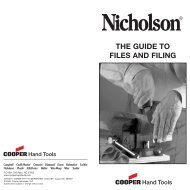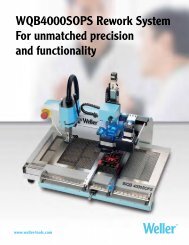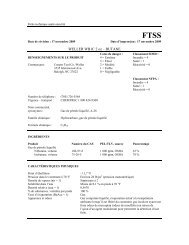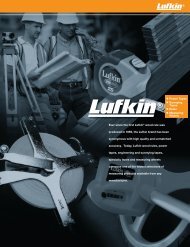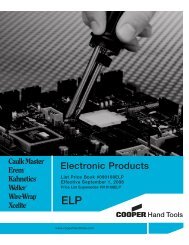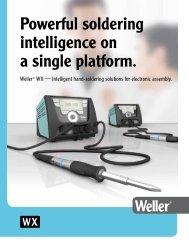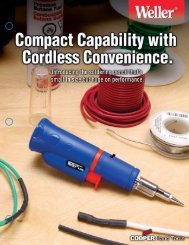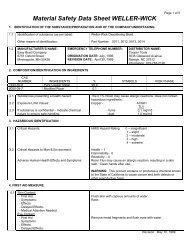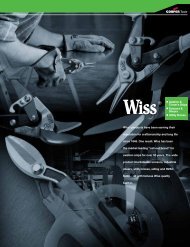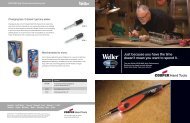Manual Cutters Hydraulic Cutters Pneumatic Cutters Since 1880 ...
Manual Cutters Hydraulic Cutters Pneumatic Cutters Since 1880 ...
Manual Cutters Hydraulic Cutters Pneumatic Cutters Since 1880 ...
Create successful ePaper yourself
Turn your PDF publications into a flip-book with our unique Google optimized e-Paper software.
CUTTING TOOLS<br />
a. When heavy cutting is involved, place one handle of the tool on the ground using foot pressure.<br />
This allows more power to be transferred to the cutting edges, and permits the cutting force to be<br />
applied to the upper handle.<br />
b. Use the correct cutting tool for the type, size, and hardness of the metal to be cut. Failure to do so can<br />
result in product damage or injury.<br />
c. Keep cutter jaws at right angles to piece being cut. Cutting diagonally may twist jaws and damage head.<br />
d. Do not twist or pry with tool while cutting.<br />
e. Do not exceed the full cut on a material whose hardness is unknown. Test hardness with slow pressure<br />
to see if material surface is being cut. The size of the metal you are cutting is not as important as<br />
material hardness.<br />
f. Do not exceed the cutter capacity that is marked on the jaw of the tool or its rating capacity in this catalog.<br />
g. Keep jaw bolts tight and joints oiled at all times. Inspect tool frequently for damage and replace worn parts.<br />
h. Maintain the original jaw bevel angles when sharpening out of line or chip cutting edges.<br />
Wear your gloves and safety glasses at all times!<br />
Do wear safety shoes.<br />
Do remove oil or grease from your hands, from tools and from the floor and area where you will be working.<br />
Do remember that metal can fly when cut. The harder the metal, the farther it will fly, and possibly cause injury.<br />
Do warn those in the area when you intend to use a cutter and protect others.<br />
Do use all tools as recommended.<br />
Don’t attempt to use a cutting, hand or power tool, until you fully understand its use.<br />
Don’t forget that metal fragments may fly and cause injury.<br />
Don’t use cutters for any application except those listed in this catalog.<br />
Don’t use H.K. Porter cutters on energized circuits, wire, or cable.<br />
Don’t use cutters that are damaged or need parts replaced due to wear.<br />
Don’t use cutter products on energized circuits, wire or cables.<br />
DANGER<br />
Indicates a high probability that<br />
death, severe bodily injury or major<br />
property damage could result.<br />
WARNING<br />
Is serious but less inevitable. There<br />
is some probability that death,<br />
severe bodily injury or property<br />
damage could result.<br />
CAUTION<br />
Is less serious but still demands<br />
attention. Indicates a hazard which<br />
may result in minor injury or<br />
property damage.<br />
Cutting Tips<br />
Safety Do’s and Dont’s<br />
Safety Precautions<br />
Hard metals may snap off or fly through the air when cut. Always wear safety<br />
glasses and warn workers nearby to prevent injury from flying metal. Take<br />
precautions such as wrapping a cloth or rag around the cutting jaws to contain<br />
fragments during cutting.<br />
The “Safety Alert Symbol” symbol to the left is used to call attention to instructions<br />
concerning personal safety. Watch for this symbol. It points out important safety<br />
precautions. It means: “ATTENTION! Stay alert, personal safety may be in danger!”<br />
Read the message that follows this symbol and be alert to the possibility of<br />
personal injury or death resulting from misuse.<br />
The use of any industrial tool may present hazards which can result in serious<br />
injury or death.<br />
READ AND UNDERSTAND ALL DIRECTIONS BEFORE<br />
OPERATING ANY H.K. PORTER ® MANUAL, HYDRAULIC<br />
OR PNEUMATIC TOOL<br />
H.K. Porter<br />
185




